Contribution of the Ratio of Tocopherol Homologs to the Oxidative Stability of Commercial Vegetable Oils
Abstract
:1. Introduction
2. Results
2.1. Quantitation of Tocopherol Homologs and Assessment of the Oxidative Status of Commercial Vegetable Oils
2.2. Analysis of the Fatty Acid Profile
2.3. Quantitation of Tocopherol Homologs in Vegetable Oils Stored under Household Conditions
2.4. Analysis of POV
2.5. Correlation Analyses between POVs and Tocopherols
2.6. Analyses of Free Radical-Scavenging Activity of α- γ- and δ-Tocopherol
2.7. Quantitation of Hexanal
3. Discussion
4. Materials and Methods
4.1. Chemicals
4.2. Oil Samples and Study Design
4.3. Quantitation of Fatty Acid Composition
4.4. Quantitation of Tocopherols
4.5. Analysis of the Peroxide Value
4.6. Measurement of Free Radical-Scavenging Activity
4.7. Quantitation of Hexanal
4.8. Statistical Analysis
5. Conclusions
Acknowledgments
Author Contributions
Conflicts of Interest
References
- Burton, G.W.; Traber, M.G. Vitamin-E: Antioxidant Activity, Biokinetics, and Bioavailability. Annu. Rev. Nutr. 1990, 10, 357–382. [Google Scholar] [CrossRef] [PubMed]
- Burton, G.W.; Ingold, K.U. Vitamin-E: Application of the Principles of Physical Organic-Chemistry to the Exploration of Its Structure and Function. Acc. Chem. Res. 1986, 19, 194–201. [Google Scholar] [CrossRef]
- Dillard, C.J.; Gavino, V.C.; Tappel, A.L. Relative Antioxidant Effectiveness of Alpha-Tocopherol and Gamma-Tocopherol in Iron-Loaded Rats. J. Nutr. 1983, 113, 2266–2273. [Google Scholar] [CrossRef] [PubMed]
- Brigelius-Flohe, R. Bioactivity of vitamin E. Nutr. Res. Rev. 2006, 19, 174–186. [Google Scholar] [CrossRef] [PubMed]
- Kamal-Eldin, A. Effect of fatty acids and tocopherols on the oxidative stability of vegetable oils. Eur. J. Lipid Sci. Technol. 2006, 108, 1051–1061. [Google Scholar] [CrossRef]
- Seppanen, C.M.; Song, Q.H.; Csallany, A.S. The Antioxidant Functions of Tocopherol and Tocotrienol Homologues in Oils, Fats, and Food Systems. J. Am. Oil Chem. Soc. 2010, 87, 469–481. [Google Scholar] [CrossRef]
- Isnardy, B.; Wagner, K.H.; Elmadfa, I. Effects of alpha, gamma, and delta-tocopherols on the autoxidation of purified rapeseed oil triacylglycerols in a system containing low oxygen. J. Agric. Food Chem. 2003, 51, 7775–7780. [Google Scholar] [CrossRef] [PubMed]
- Wagner, K.H.; Isnardy, B.; Elmadfa, I. γ- and δ-tocopherols are more effective than α-tocopherol on the autoxidation of a 10% rapeseed oil triacylglycerol-in-water emulsion with and without a radical initiator. Eur. J. Lipid Sci. Technol. 2004, 106, 44–51. [Google Scholar] [CrossRef]
- Evans, J.C.; Kodali, D.R.; Addis, P.B. Optimal tocopherol concentrations to inhibit soybean oil oxidation. J. Am. Oil Chem. Soc. 2002, 79, 47–51. [Google Scholar] [CrossRef]
- Ayyildiz, H.F.; Topkafa, M.; Kara, H.; Sherazi, S.T.H. Evaluation of Fatty Acid Composition, Tocols Profile, and Oxidative Stability of Some Fully Refined Edible Oils. Int. J. Food Prop. 2015, 18, 2064–2076. [Google Scholar] [CrossRef]
- Carlsson, D.J.; Suprunchuk, T.; Wiles, D.M. Photooxidation of Unsaturated Oils: Effects of Singlet Oxygen Quenchers. J. Am. Oil Chem. Soc. 1976, 53, 656–660. [Google Scholar] [CrossRef]
- Jung, M.Y.; Yoon, S.H.; Min, D.B. Effects of processing steps on the contents of minor compounds and oxidation of soybean oil. J. Am. Oil Chem. Soc. 1989, 66, 118–120. [Google Scholar] [CrossRef]
- Pignitter, M.; Stolze, K.; Gartner, S.; Dumhart, B.; Stoll, C.; Steiger, G.; Kraemer, K.; Somoza, V. Cold fluorescent light as major inducer of lipid oxidation in soybean oil stored at household conditions for eight weeks. J. Agric. Food Chem. 2014, 62, 2297–2305. [Google Scholar] [CrossRef] [PubMed]
- Choe, E.; Min, D.B. Mechanisms and factors for edible oil oxidation. Compr. Rev. Food Sci. Food Saf. 2006, 5, 169–186. [Google Scholar] [CrossRef]
- Frankel, E.N. Review. Recent advances in lipid oxidation. J. Sci. Food Agric. 1991, 54, 495–511. [Google Scholar] [CrossRef]
- Bianchi, L.M.; Duncan, S.E.; Webster, J.B.; Neilson, A.P.; O’Keefe, S.F. Contribution of Chlorophyll to Photooxidation of Soybean Oil at Specific Visible Wavelengths of Light. J. Food Sci. 2015, 80, C252–C261. [Google Scholar] [CrossRef] [PubMed]
- Shahidi, F.; Zhong, Y. Lipid oxidation and improving the oxidative stability. Chem. Soc. Rev. 2010, 39, 4067–4079. [Google Scholar] [CrossRef] [PubMed]
- Gunstone, F.D. Producers, importers, exporters, and consumers of the three major oilseeds and the four major vegetable oils. Lipid Technol. 2013, 25, 288. [Google Scholar] [CrossRef]
- Petersen, K.D.; Kleeberg, K.K.; Jahreis, G.; Fritsche, J. Assessment of the oxidative stability of conventional and high-oleic sunflower oil by means of solid-phase microextraction-gas chromatography. Int. J. Food Sci. Nutr. 2012, 63, 160–169. [Google Scholar] [CrossRef] [PubMed]
- Guadagnin, M.; Cattani, M.; Bailoni, L. Effect of pressing and combination of three storage temperatures and times on chemical composition and fatty acid profile of canola expellers. Ital. J. Anim. Sci. 2013, 12, e43. [Google Scholar] [CrossRef]
- Morales, A.; Marmesat, S.; Ruiz-Mendez, M.V.; Marquez-Ruiz, G.; Velasco, J. Formation of oxidation products in edible vegetable oils analyzed as FAME derivatives by HPLC-UV-ELSD. Food Res. Int. 2014, 62, 1080–1086. [Google Scholar] [CrossRef]
- Lewinska, A.; Zebrowski, J.; Duda, M.; Gorka, A.; Wnuk, M. Fatty Acid Profile and Biological Activities of Linseed and Rapeseed Oils. Molecules 2015, 20, 22872–22880. [Google Scholar] [CrossRef] [PubMed]
- Kim, W.W.; Rho, H.S.; Hong, Y.D.; Yeom, M.H.; Shin, S.S.; Yi, J.G.; Lee, M.S.; Park, H.Y.; Cho, D.H. Determination and comparison of seed oil triacylglycerol composition of various soybeans (Glycine max (L.)) using (1)H-NMR spectroscopy. Molecules 2013, 18, 14448–14454. [Google Scholar] [CrossRef] [PubMed]
- Li, C.M.; Yao, Y.P.; Zhao, G.Z.; Cheng, W.; Liu, H.L.; Liu, C.Y.; Shi, Z.; Chen, Y.; Wang, S. Comparison and Analysis of Fatty Acids, Sterols, and Tocopherols in Eight Vegetable Oils. J. Agric. Food Chem. 2011, 59, 12493–12498. [Google Scholar] [CrossRef] [PubMed]
- Di Mambro, V.M.; Azzolini, A.E.C.S.; Valim, Y.M.L.; Fonseca, M.J.V. Comparison of antioxidant activities of tocopherols alone and in pharmaceutical formulations. Int. J. Pharm. 2003, 262, 93–99. [Google Scholar] [CrossRef]
- Schieberle, P.; Grosch, W. Model Experiments About the Formation of Volatile Carbonyl-Compounds. J. Am. Oil Chem. Soc. 1981, 58, 602–607. [Google Scholar] [CrossRef]
- Chen, B.C.; McClements, D.J.; Decker, E.A. Minor Components in Food Oils: A Critical Review of their Roles on Lipid Oxidation Chemistry in Bulk Oils and Emulsions. Crit. Rev. Food Sci. 2011, 51, 901–916. [Google Scholar] [CrossRef] [PubMed]
- Duthie, G.G.; Gardner, P.T.; Morrice, P.C.; McPhail, D.B. The Contribution of dα-Tocopherol and dγ-Tocopherol to the Antioxidant Capacity of Several Edible Plant Oils. Nat. Sci. 2016, 8, 41–48. [Google Scholar]
- Matthaus, B.; Ozcan, M.M.; Al Juhaimi, F. Some rape/canola seed oils: Fatty acid composition and tocopherols. J. Biosci. 2016, 71, 73–77. [Google Scholar] [CrossRef] [PubMed]
- Vera-Ruiz, E.M.; Velasco, L.; Leon, A.J.; Fernandez-Martinez, J.; Perez-Vich, B. Genetic mapping of the Tph1 gene controlling beta-tocopherol accumulation in sunflower seeds. Mol. Breed. 2006, 17, 291–296. [Google Scholar] [CrossRef]
- Pignitter, M.; Dumhart, B.; Gartner, S.; Jirsa, F.; Steiger, G.; Kraemer, K.; Somoza, V. Vitamin A is rapidly degraded in retinyl palmitate-fortified soybean oil stored under household conditions. J. Agric. Food Chem. 2014, 62, 7559–7566. [Google Scholar] [CrossRef] [PubMed]
- Grilo, E.C.; Costa, P.N.; Gurgel, C.S.S.; Beserra, A.F.D.; Almeida, F.N.D.; Dimenstein, R. Alpha-tocopherol and gamma-tocopherol concentration in vegetable oils. Food Sci. Technol. 2014, 34, 379–385. [Google Scholar] [CrossRef]
- Winkler-Moser, J.K.; Logan, A.; Bakota, E.L. Antioxidant activities and interactions of α- and γ-tocopherols within canola and soybean oil emulsions. Eur. J. Lipid Sci. Technol. 2014, 116, 606–617. [Google Scholar] [CrossRef]
- Sikorska, E.; Gliszczynska-Swiglo, A.; Khmelinskii, I.; Sikorski, M. Synchronous fluorescence spectroscopy of edible vegetable oils. Quantification of tocopherols. J. Agric. Food Chem. 2005, 53, 6988–6994. [Google Scholar] [CrossRef] [PubMed]
- Galeano-Diaz, T.; Acedo-Valenzuela, M.I.; Silva-Rodriguez, A. Determination of tocopherols in vegetable oil samples by non-aqueous capillary electrophoresis (NACE) with fluorimetric detection. J. Food Compos. Anal. 2012, 25, 24–30. [Google Scholar] [CrossRef]
- Schwartz, H.; Ilainen, V.; Pfironen, V.; Lampi, M.A. Tocopherol, tocotrienol and plant sterol contents of vegetable oils and industrial fats. J. Food Compos. Anal. 2008, 21, 152–161. [Google Scholar] [CrossRef]
- Mailer, R.J.; Ayton, J.; Graham, K. The Influence of Growing Region, Cultivar and Harvest Timing on the Diversity of Australian Olive Oil. J. Am. Oil Chem. Soc. 2010, 87, 877–884. [Google Scholar] [CrossRef]
- Rani, A.; Kumar, V.; Verma, S.K.; Shakya, A.K.; Chauhan, G.S. Tocopherol content and profile of soybean: Genotypic variability and correlation studies. J. Am. Oil Chem. Soc. 2007, 84, 377–383. [Google Scholar] [CrossRef]
- FAO/WHO. Codex Alimentarius—Standard for named vegetable oils. In Other Quality and Composition Factors; CODEX Alimentarius Commission: Geneva, Switzerland, 2001; pp. 1–13. [Google Scholar]
- Vrbikova, L.; Schmidt, S.; Kreps, F.; Tmakova, L.; Certik, M.; Sekretar, S. Degradation of Selected Nutrients in Sunflower Oils during Long-Term Storage. Czech J. Food Sci. 2014, 32, 595–600. [Google Scholar]
- Wroniak, M.; Rękas, A. Nutritional value of cold-pressed rapeseed oil during long term storage as influenced by the type of packaging material, exposure to light & oxygen and storage temperature. J. Food Sci. Technol. 2016, 53, 1338–1347. [Google Scholar] [CrossRef] [PubMed]
- Cao, J.; Li, H.Y.; Xia, X.; Zou, X.G.; Li, J.; Zhu, X.M.; Deng, Z.Y. Effect of Fatty Acid and Tocopherol on Oxidative Stability of Vegetable Oils with Limited Air. Int. J. Food Prop. 2015, 18, 808–820. [Google Scholar] [CrossRef]
- Liu, H.R.; White, P.J. Oxidative Stability of Soybean Oils with Altered Fatty-Acid Compositions. J. Am. Oil Chem. Soc. 1992, 69, 528–532. [Google Scholar] [CrossRef]
- Jung, M.Y.; Min, D.B. Effects of Alpha-Tocopherol, Gamma-Tocopherol, and Delta-Tocopherol on Oxidative Stability of Soybean Oil. J. Food Sci. 1990, 55, 1464–1465. [Google Scholar] [CrossRef]
- Huang, S.W.; Frankel, E.N.; German, J.B. Antioxidant Activity of Alpha-Tocopherols and Gamma-Tocopherols in Bulk Oils and in Oil-in-Water Emulsions. J. Agric. Food Chem. 1994, 42, 2108–2114. [Google Scholar] [CrossRef]
- Ha, K.-H.; Igarashi, O. The Oxidation Products from Two Kinds of Tocopherols Co-Existing in Autoxidation System of Methyl Linoleate. J. Nutr. Sci. Vitaminol. 1990, 36 (4-SupplementI), 411–421. [Google Scholar] [CrossRef]
- Lea, C.H.; Ward, R.J. Relative antioxidant activities of the seven tocopherols. J. Sci. Food Agric. 1959, 10, 537–548. [Google Scholar] [CrossRef]
- Fujisawa, S.; Kadoma, Y. Kinetic study of the radical-scavenging activity of vitamin E and ubiquinone. In Vivo 2005, 19, 1005–1011. [Google Scholar] [PubMed]
- Hass, C.G.; Tang, S.X.; Leonard, S.; Traber, M.G.; Miller, J.F.; Knapp, S.J. Three non-allelic epistatically interacting methyltransferase mutations produce novel tocopherol (vitamin E) profiles in sunflower. Theor. Appl. Genet. 2006, 113, 767–782. [Google Scholar] [CrossRef] [PubMed]
- Tang, S.X.; Hass, C.G.; Knapp, S.J. Ty3/gypsy-like retrotransposon knockout of a 2-methyl-6-phytyl-1,4-benzoquinone methyltransferase is non-lethal, uncovers a cryptic paralogous mutation, and produces novel tocopherol (vitamin E) profiles in sunflower. Theor. Appl. Genet. 2006, 113, 783–799. [Google Scholar] [CrossRef] [PubMed]
- Demurin, Y.; Skoric, D.; Karlovic, D. Genetic variability of tocopherol composition in sunflower seeds as a basis of breeding for improved oil quality. Plant Breed. 1996, 115, 33–36. [Google Scholar] [CrossRef]
- Karunanandaa, B.; Qi, Q.G.; Hao, M.; Baszis, S.R.; Jensen, P.K.; Wong, Y.H.H.; Jiang, J.; Venkatramesh, M.; Gruys, K.J.; Moshiri, F.; et al. Metabolically engineered oilseed crops with enhanced seed tocopherol. Metab. Eng. 2005, 7, 384–400. [Google Scholar] [CrossRef] [PubMed]
- Brigelius-Flohe, R.; Traber, M.G. Vitamin E: Function and metabolism. FASEB J. 1999, 13, 1145–1155. [Google Scholar] [PubMed]
- Firestone, D. Method Cd 8-53, 4th ed.; American Oil Chemists’ Society: Champaign, IL, USA, 1997. [Google Scholar]
- Hofer, P.; Carl, P. Method for Determining the Absolute Number of Electron Spins in a Sample of Extended Size. U.S. Patent 7,586,305 B2, 8 September 2009. [Google Scholar]
Sample Availability: Samples of the reference compounds are available from the authors. |
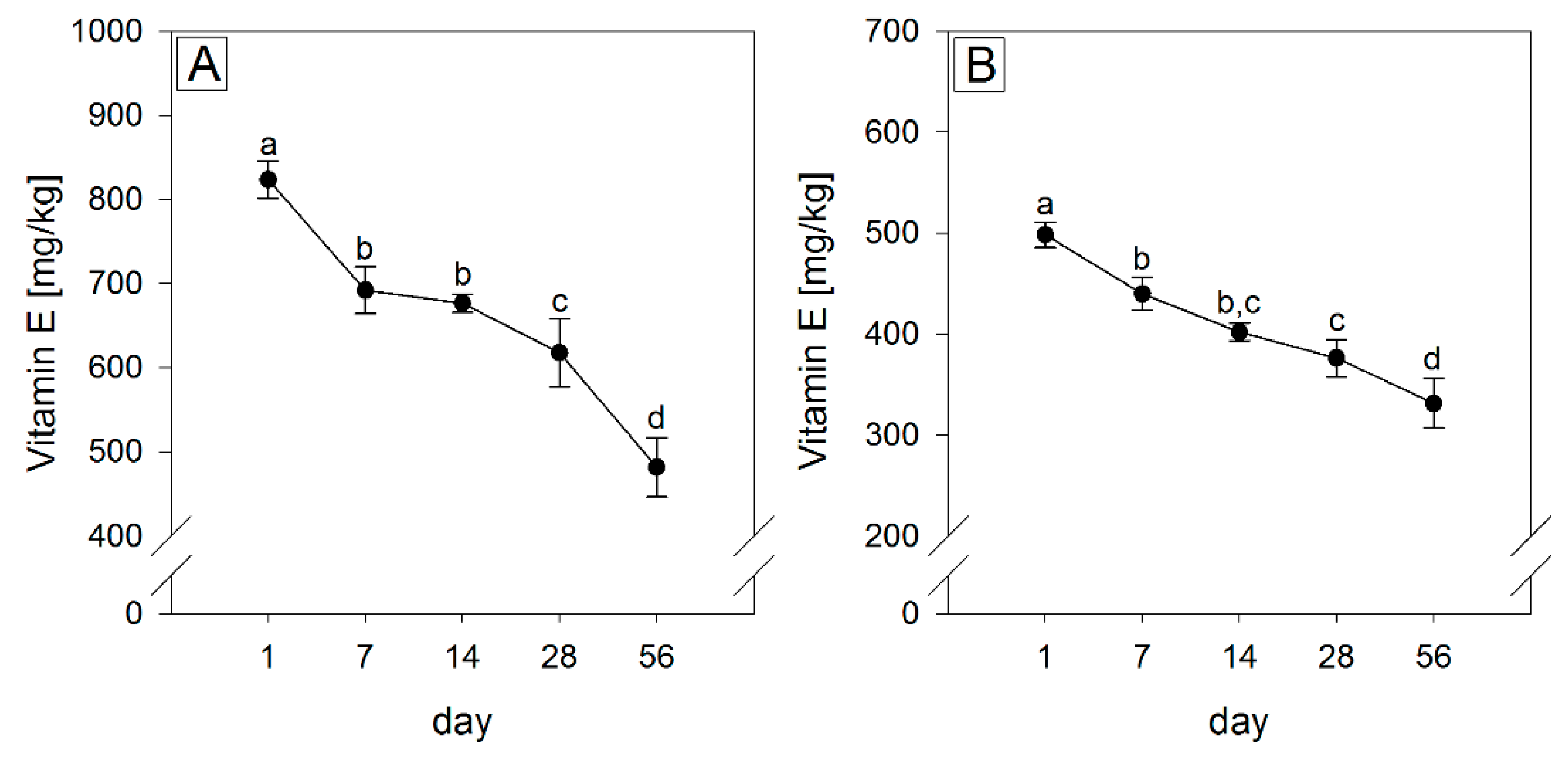
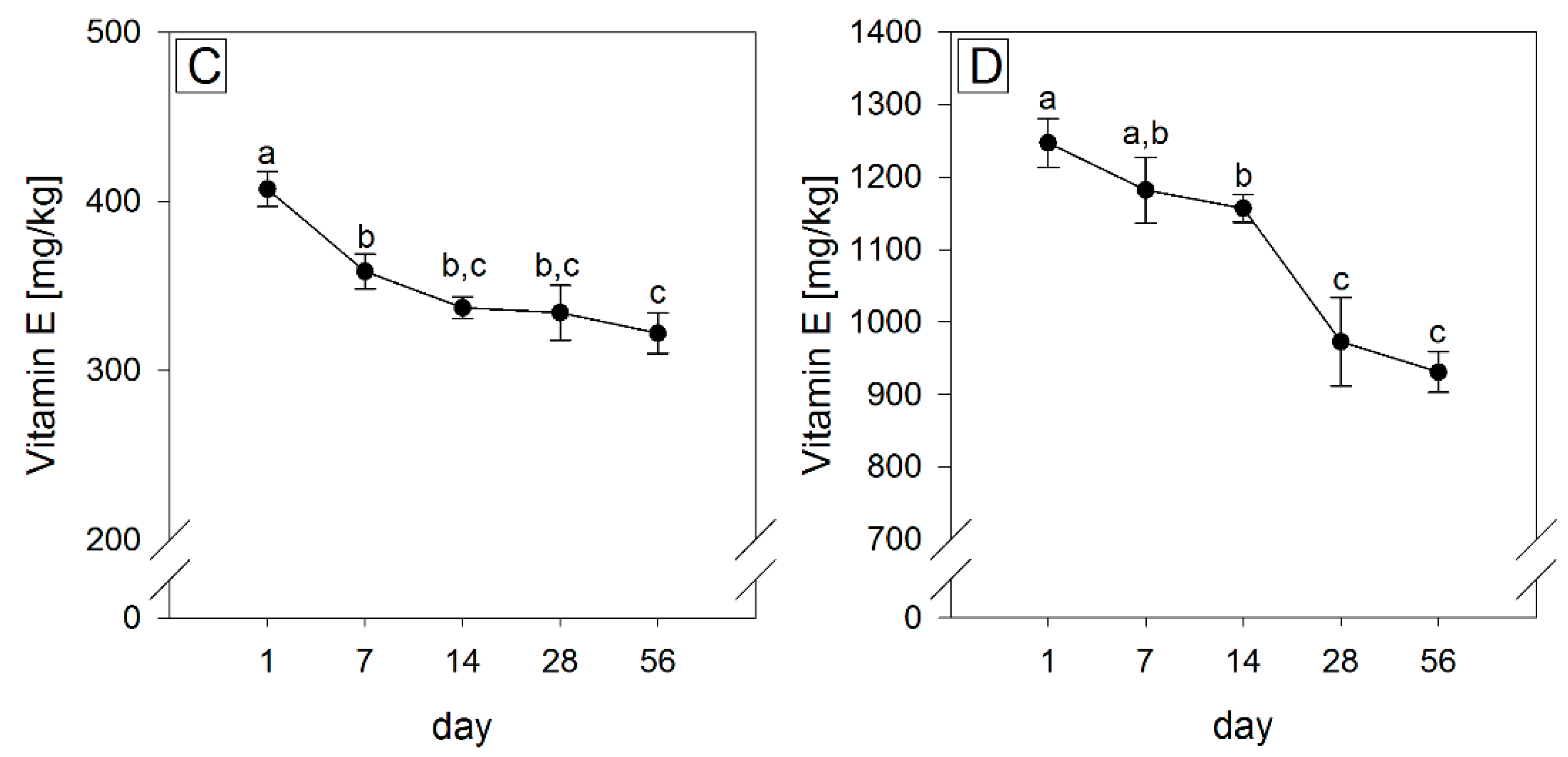
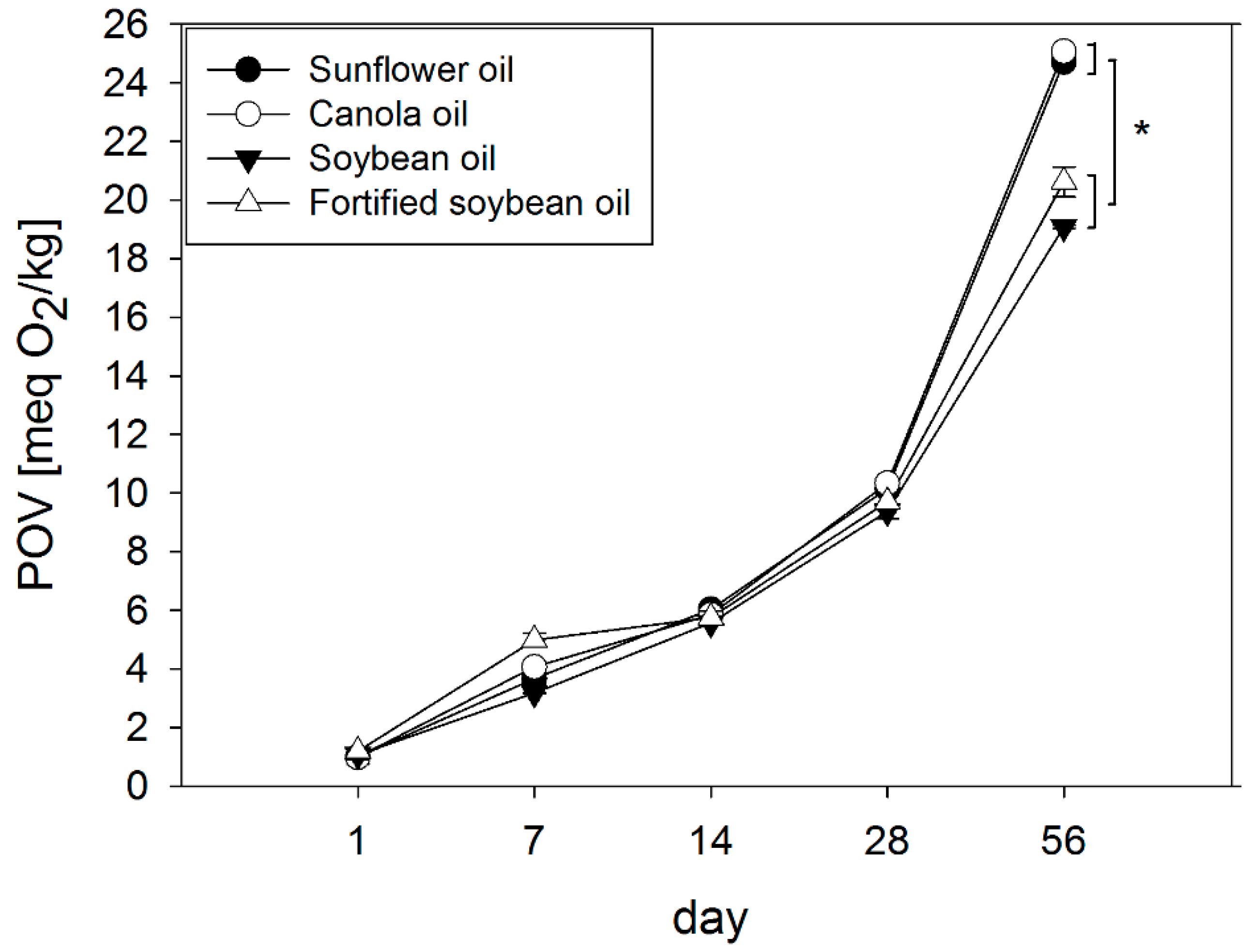

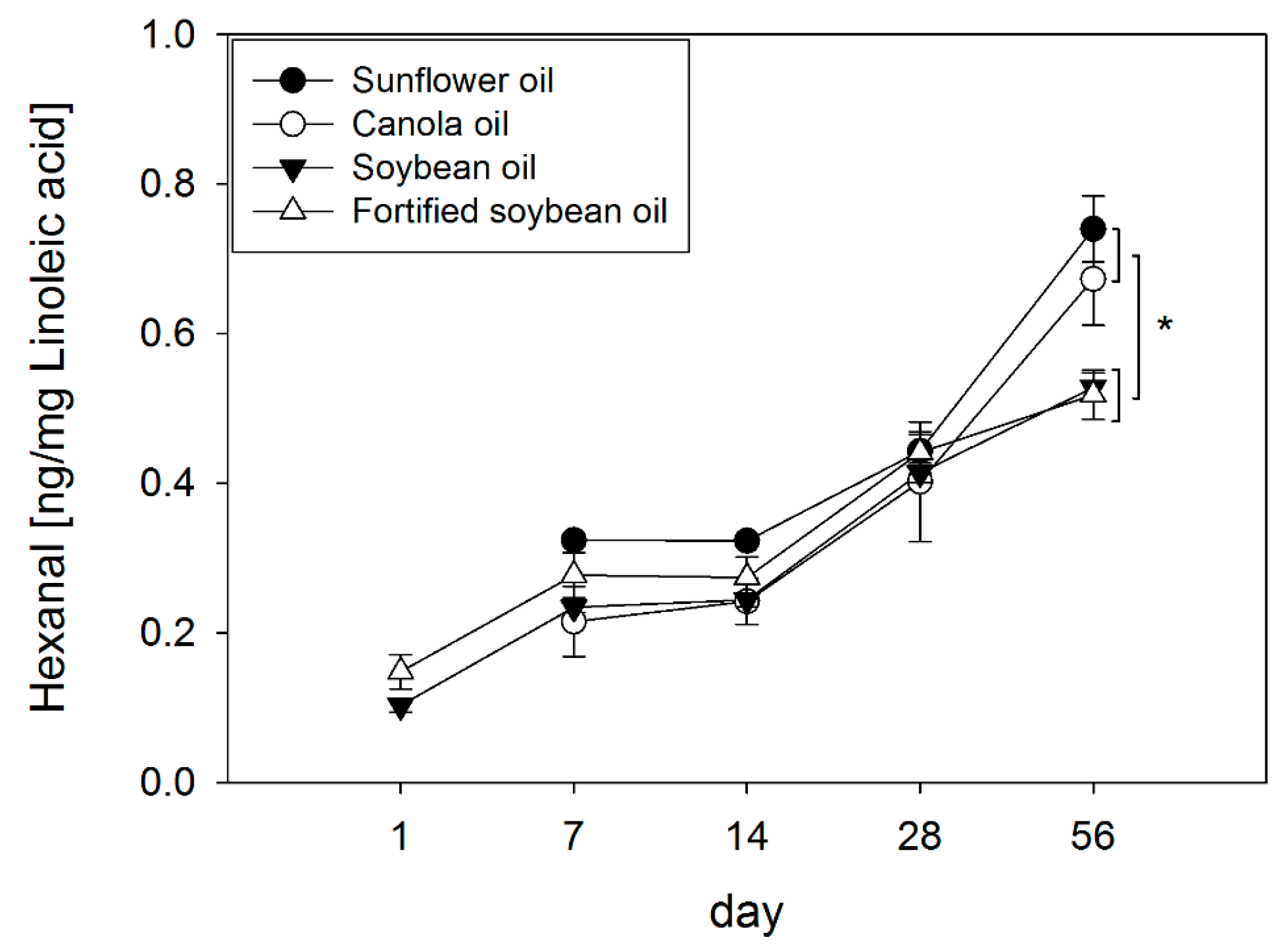
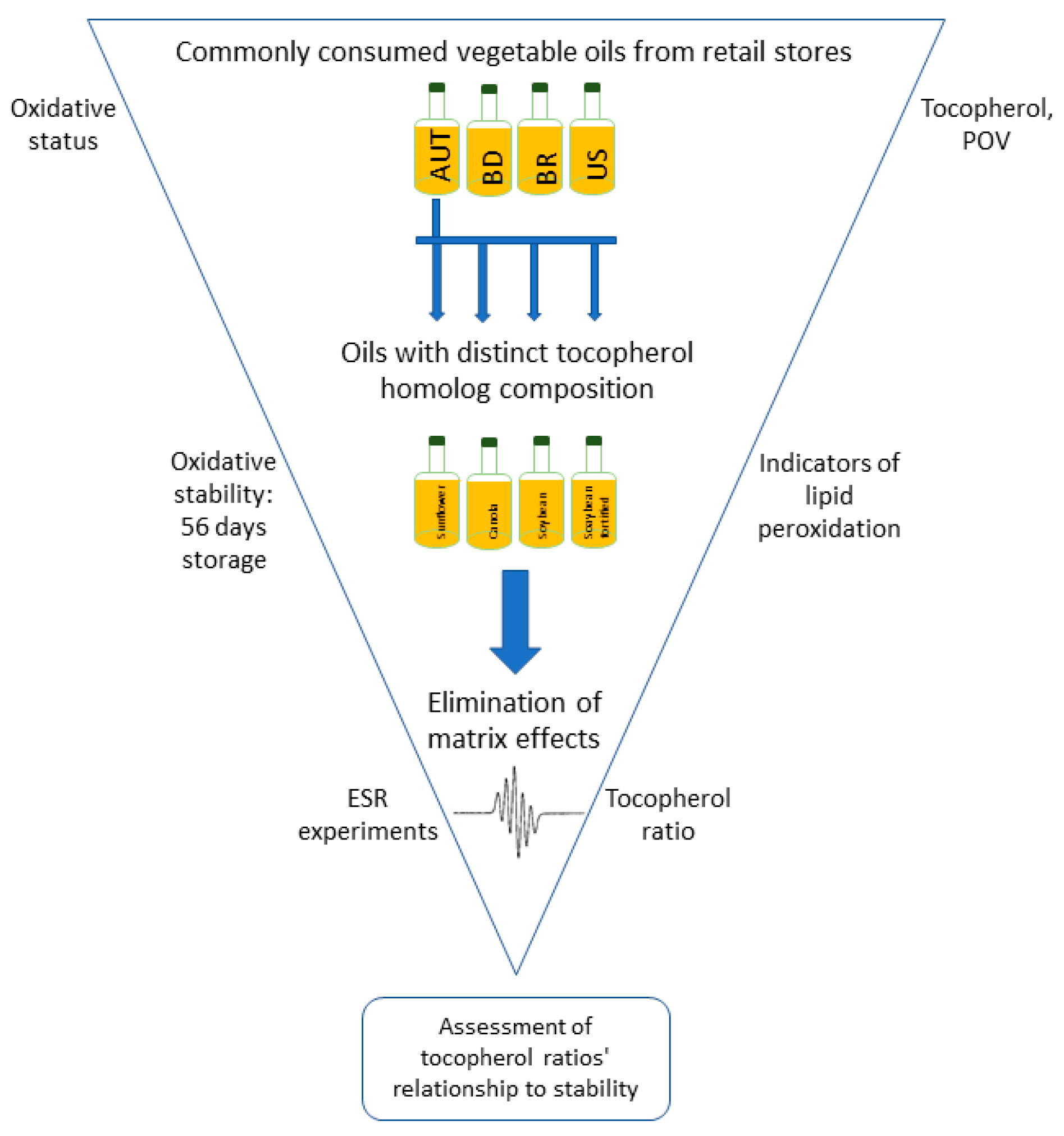
| Canola Oil (n = 15) | Corn Oil (n = 2) | Olive Oil (n = 18) | Soybean Oil (n = 15) | Sunflower Oil (n = 5) | |
|---|---|---|---|---|---|
| Tocopherols | |||||
| (mg/kg) | |||||
| α | 312 ± 70.2 | 682 ± 143 | 290 ± 37.2 | 215 ± 34.9 | 648 ± 127 |
| γ | 389 ± 72.7 | 793 ± 126 | 126 ± 11.2 | 659 ± 121 | 131 ± 2.50 |
| δ | 95.2 ± 5.40 | 104 ± 10.8 | n.d. | 264 ± 35.6 | n.d. |
| total | 714 ± 139 | 1580 ± 280 | 331 ± 86.4 | 1138 ± 167 | 713 ± 160 |
| POV | |||||
| (meq O2/kg) | 2.49 ± 1.03 | 2.35 ± 0.8 | 6.70 ± 2.34 | 1.87 ± 0.64 | 2.66 ± 0.98 |
| Fatty Acid | Sunflower Oil | Canola Oil | Soybean Oil |
|---|---|---|---|
| [Relative %] | |||
| C14:0 | n.d. | 0.07 ± 0.01 | n.d. |
| C16:0 | 4.47 ± 0.16 a | 4.89 ± 0.72 b | 11.5 ± 0.14 c |
| C18:0 | 2.82 ± 0.15 a | 1.72 ± 0.28 b | 3.62 ± 0.14 a |
| C18:1 | 76.7 ± 3.47 a | 63.9 ± 10.3 a | 24.0 ± 0.47 c |
| C18:2 | 15.4 ± 0.61 a | 20.5 ± 3.24 a | 54.6 ± 0.63 b |
| C18:3 | 0.20 ± 0.01 a | 6.37 ± 0.71 b | 5.87 ± 0.07 b |
| C20:0 | 0.34 ± 0.01 a | 0.60 ± 0.10 b | 0.46 ± 0.03 a,b |
| C22:0 | n.d. | 1.04 ± 0.07 | n.d. |
| C22:1 | n.d. | 0.71 ± 0.03 | n.d. |
| C24:0 | n.d. | 0.17 ± 0.04 | n.d. |
| P/S ratio | 2.04 a | 3.16 b | 3.88 c |
| Oil Type | Tocopherols | Day 1 | Day 7 | Day 14 | Day 28 | Day 56 | Day 1–56 |
|---|---|---|---|---|---|---|---|
| (mg/kg) | −Δ [%] | ||||||
| Sunflower | α | 788 ± 20.6 | 660 ± 29.2 * | 642 ± 11.7 * | 587 ± 40.3 * | 455 ± 32.8 * | 42.3 ± 4.16 a |
| γ | 35.7 ± 2.63 | 31.3 ± 1.65 | 34.0 ± 1.55 | 30.2 ± 0.74 * | 26.9 ± 2.85 * | 24.7 ± 8.00 b,d | |
| Canola | α | 235 ± 6.16 | 198 ± 13.9 * | 181 ± 4.28 * | 170 ± 7.71 * | 138 ± 11.5 * | 41.0 ± 4.91 a |
| γ | 263 ± 6.44 | 242 ± 2.82 | 221 ± 4.64 * | 206 ± 10.8 * | 193 ± 13.0 * | 26.8 ± 4.95 b,d | |
| Soybean | α | 68.9 ± 2.97 | 59.7 ± 1.71 * | 57.9 ±1.74 * | 57.6 ±3.36 * | 55.9 ± 3.29 * | 19.0 ± 4.78 b,c,d |
| γ | 273 ± 6.76 | 239 ± 6.05 * | 221 ± 4.68 * | 217 ± 10.5 * | 208 ± 6.89 * | 23.8 ± 2.52 b,d | |
| δ | 64.8 ± 0.87 | 60.1 ± 2.66 * | 58.2 ± 0.68 * | 59.4 ± 2.47 * | 57.8 ± 2.04 * | 10.9 ± 3.15 c | |
| Fortified soybean | α | 192 ± 4.69 | 192 ± 7.29 | 182 ± 3.00 | 145 ± 8.79 * | 158 ± 5.69 * | 17.9 ± 3.00 b,c |
| γ | 843 ± 24.0 | 791 ± 30.1 * | 782 ± 14.9 * | 655 ± 42.2 * | 599 ± 18.5 * | 29.0 ± 2.20 d | |
| δ | 212 ± 5.02 | 199 ± 0.09 | 193 ± 5.63 * | 168 ± 10.1 * | 174 ± 4.21 * | 17.6 ± 2.00 b,c | |
| Total Tocopherols | alpha-Tocopherol | gamma-Tocopherol | delta-Tocopherol | Tocopherol Ratio | |
|---|---|---|---|---|---|
| −Δ [%] | −Δ [%] | −Δ [%] | −Δ [%] | (γ + δ)/α | |
| POV +Δ [%] | r = 0.82 | r = 0.95 | r = 0.08 | r = −0.64 | r = −0.97 |
| p < 0.001 | p < 0.001 | p = 0.77 | p = 0.09 | p < 0.001 |
© 2018 by the authors. Licensee MDPI, Basel, Switzerland. This article is an open access article distributed under the terms and conditions of the Creative Commons Attribution (CC BY) license (http://creativecommons.org/licenses/by/4.0/).
Share and Cite
Zaunschirm, M.; Pignitter, M.; Kienesberger, J.; Hernler, N.; Riegger, C.; Eggersdorfer, M.; Somoza, V. Contribution of the Ratio of Tocopherol Homologs to the Oxidative Stability of Commercial Vegetable Oils. Molecules 2018, 23, 206. https://doi.org/10.3390/molecules23010206
Zaunschirm M, Pignitter M, Kienesberger J, Hernler N, Riegger C, Eggersdorfer M, Somoza V. Contribution of the Ratio of Tocopherol Homologs to the Oxidative Stability of Commercial Vegetable Oils. Molecules. 2018; 23(1):206. https://doi.org/10.3390/molecules23010206
Chicago/Turabian StyleZaunschirm, Mathias, Marc Pignitter, Julia Kienesberger, Natalie Hernler, Christoph Riegger, Manfred Eggersdorfer, and Veronika Somoza. 2018. "Contribution of the Ratio of Tocopherol Homologs to the Oxidative Stability of Commercial Vegetable Oils" Molecules 23, no. 1: 206. https://doi.org/10.3390/molecules23010206





